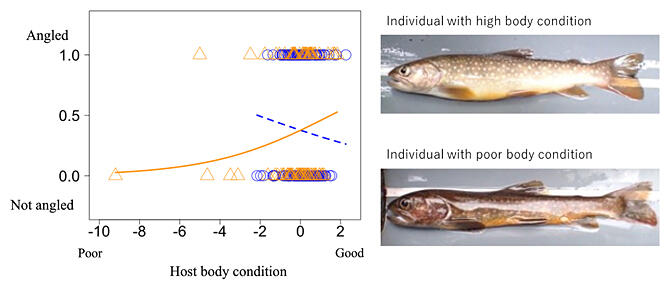Graduate student Ryota Hasegawa and Associate Professor Itsuro Koizumi of the Faculty of Environmental Earth Sciences at Hokkaido University have shown that a crustacean (Salmincola) parasite in the mouth of the host, char, affects the catchability of the freshwater fish. They found that the ease of being caught when infected by a parasite varied according to the obesity (condition) of the char. Their findings were published online in The Science of Nature.

Provided by Hokkaido University
In general, parasites exploit the energy of the host and infected fish are thought to become less active. This means that infected fish are expected to search for and eat bait less frequently, making them harder to catch. If this hypothesis is correct, this is good news for anglers, as it means that fish caught are less likely to have parasites on them.
The research team focused on char (Salmo trutta), which live in mountain streams in Hokkaido, and the parasite in their mouths, Salmincola (parasitic copepod). The char is a salmonid fish that lives in clean mountain streams and is popular for fishing throughout Japan due to its good taste. Salmincola is a parasite of the mouth of char, and previous studies have shown that infected char lose their appetite and become emaciated. Infected char were also thought to be more difficult to catch, as foreign bodies (parasites) in the mouth can interfere with direct foraging.
The researchers firstly conducted a field survey in a river on the outskirts of Hakodate City, where past fishing history could be disregarded because fishing is banned, and the river can be examined in its natural state. The research team obtained a special catch permit for their survey. Hasegawa caught char using caterpillars as bait and then used an electric shocker to capture char that had remained in the river without being caught. If the hypothesis is correct, this should result in a lower rate of parasite infection in caught char than in char caught with the electric shocker. In their statistical analysis, they checked for the presence of parasites, and constructed a statistical model and evaluated the fish using body length and degree of obesity (condition) as explanatory variables, which have previously been shown to affect the fish's catchability.
They caught 312 char, of which 124 (40%) were caught by fishing. At first glance, there was no significant difference between the Salmincola infection rate of 37.1% in char caught and 34% in the char captured with the electric shocker. However, statistical analyses considering several explanatory variables revealed, in addition to larger body size being more likely to be caught, an interaction between parasite presence and degree of obesity influenced catchability.
In other words, higher levels of obesity in infected fish meant they were more likely to be caught, while lower levels of obesity meant they were less likely to be caught. The latter result was in line with initial predictions, as infected and emaciated individuals were less likely to be caught since they were less fit and less likely to actively feed. The former result was the opposite of what was predicted, but the researchers felt that while the fish were fat and strong, they actively fed (compensatory behavior) to regain the energy exploited by the parasite.
For anglers, the results were not good news, but it is adequately conceivable that infected fish may not be consistently caught, depending on the species of fish and the parasite. In addition, most parasites, including Salmincola, are harmless to humans. Instead, they alter the behavior and ecology of fish. It is hoped that the findings will inspire similar research around the world and also improve anglers' understanding of the parasite.
This article has been translated by JST with permission from The Science News Ltd. (https://sci-news.co.jp/). Unauthorized reproduction of the article and photographs is prohibited.




